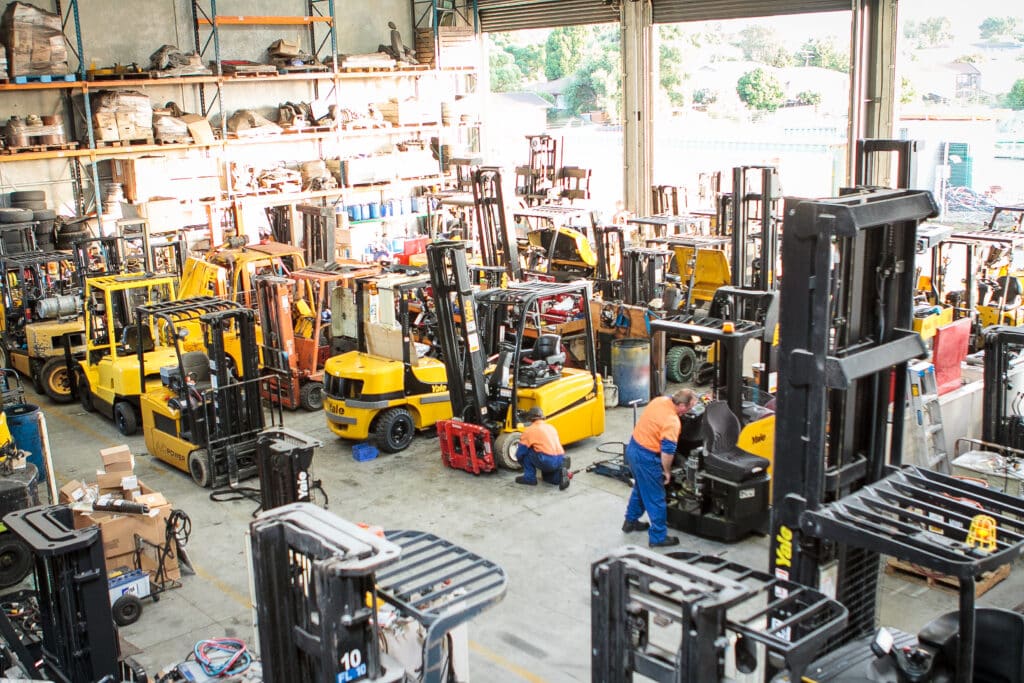What’s Right for Your Business?
When choosing the right forklift for your business, there are two main options: counterbalance or reach forklifts. Both forklifts have unique advantages and applications, but which one is better for your business? This blog post debates counterbalance vs reach forklifts to help you make the right choice when finding a forklift for hire.
Counterbalance Forklifts
Chances are, if you’re using a forklift in your warehouse, it will be a counterbalance forklift. As the name suggests, these forklifts are designed with a heavy counterweight at the rear of the machine to balance the load lifted at the front. Counterbalance forklifts are versatile, stable, and easy to use, making them suitable for various applications.
One of the main advantages of a counterbalance forklift is stability. The counterweight at the forklift’s rear provides a solid base that prevents it from tipping over when lifting heavy loads. This stability makes counterbalance forklifts ideal for loading and unloading trucks and moving heavy loads around
a worksite.
Another advantage of counterbalance forklifts is their versatility. These forklifts can be used indoors or outdoors and can handle various loads, from small to large. They can also be fitted with different attachments, such as clamps, forks, and rotators, to accommodate different load shapes and sizes.
Reach Forklifts
Reach forklifts are the smaller, more agile younger brother, designed for use in narrow aisles and confined spaces. These forklifts have a unique design that allows them to extend the load beyond the base of the machine, enabling them to reach higher than counterbalance forklifts. Reach forklifts are ideal for warehouses with high shelving, limited floor space, and narrow aisles.
One of the main advantages of a reach forklift is maneuverability. These forklifts can operate in tight spaces and narrow aisles, making them ideal for warehouses and storage facilities.
Another advantage of reach forklifts is their reach capacity. These forklifts can extend the load beyond the machine’s base, allowing them to reach higher than counterbalance forklifts. This feature makes them ideal for use in high-shelving units and storage racks.
Comparison of Counterbalance and Reach Forklifts
When comparing counterbalance vs reach forklifts, several key differences exist. Counterbalance forklifts typically have a higher load capacity than reach forklifts, making them better suited for lifting heavy loads. They also have a wider turning radius, making it more challenging to manoeuvre in tight spaces.
Reach forklifts, on the other hand, have a higher lifting height than counterbalance forklifts, making them ideal for use in warehouses with high shelving. They also have a narrower turning radius, which makes them more manoeuvrable in tight spaces.
Choosing the Right Forklift for Your Business
When choosing between counterbalance and reach forklifts, it’s important to consider your business’s specific needs and applications. A counterbalance forklift may be better for heavy loads and outdoor manoeuvrability. A reach forklift may be more suitable when lifting loads to high shelving or manoeuvre in narrow aisles.
As one of New Zealand’s leading forklift companies, Yale Forklifts NZ offers various counterbalance and reach forklifts to suit any business’s needs.
OUR PRODUCTS
CONNECT WITH US
CUSTOMER SERVICE
CONTACT US
Head Office: 09 268 4610
10 Marphona Crescent, Takanini,
Auckland 2105
PO Box 97156, Manukau City,
Auckland 2241
Te Puke Branch (07) 281 1870
6 Te Puke Quarry Road, Te Puke.
Open Mon-Fri 8am-6pm
Weekends & other times by appointment
SIGN UP TO OUR REGULAR EMAIL
Be first to know about our New & Used vehicles, our material handling solutions, and promotions.
© Copyright 2025 SG EQUIPMENT All Rights Reserved.



